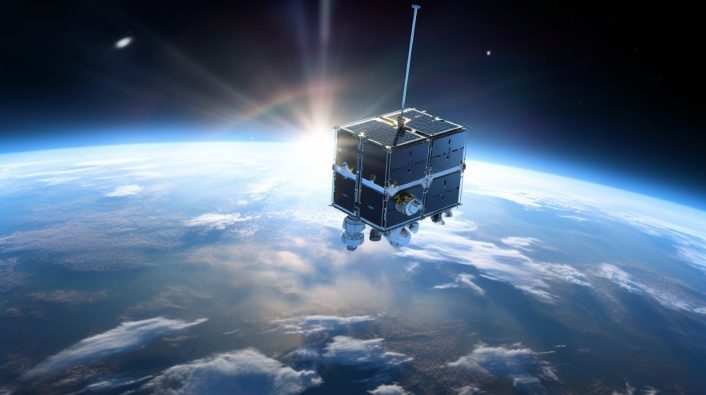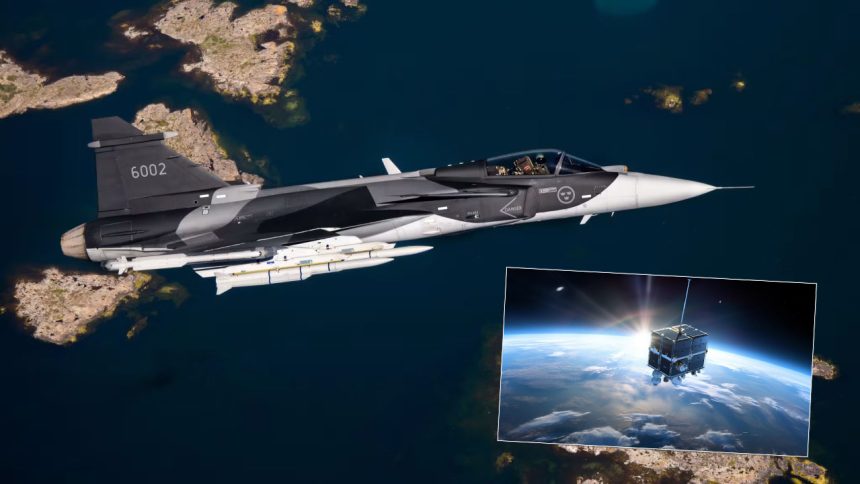The Stella study revolves around Sweden’s pioneering ACE and dispersed operations doctrine
Sweden is studying the feasibility of launching a small satellite from a Saab Gripen multirole fighter jet, the Swedish Air Force revealed last week at the Farnborough Air Show. This follows its new armed forces space strategy and complements its dispersed operations concept that dictates both its military doctrine and the Gripen’s own design philosophy and tactical orientation.
Following Stockholm’s accession to NATO (North Atlantic Treaty Organization) on March 7, 2024, the plan appears to be aimed at countering Russian airpower, which may struggle with significant radar and reconnaissance blind spots on the various roads and smaller airfields in Sweden from which the Gripens might operate during a conflict. Many of these are possibly surrounded by mountain ranges and passes, making reconnaissance difficult. The Flygvapnet is likely to operate its highly capable Generation 4++ Gripens from roads and dispersed locations in these very features.
Some NATO nations like Norway have also begun landing their F-35As on roads and unveiled the stealth jets parked in mountain hangar complexes. Moreover, F-35s from air forces like Denmark have starting flying with Swedish Saab Gripens, marking the commencement of developing teaming tactics with the single-engine delta-wing jet.
Loaded Gripen C above the clouds pic.twitter.com/CmzSyzb3i4
— Fighterman_FFRC (@Fighterman_FFRC) May 28, 2023
Nascent stage
While speaking to journalists at the air show, Col. Ella Carlsson, head of the Swedish Air Force’s Space Division identified the project as the Stella study. In collaboration with the country’s Defense Research Agency, examines the “potential for the Gripen to launch a small satellite into LEO (Low Earth Orbit),” Breaking Defense quoted Carlsson. She was speaking at a Swedish Air Force Fan Club event at Farnborough on Jul. 21, 2024.
But the entire effort, is in a very nascent stage which might not necessarily translate into an operational capability. “As regards the specifics of the Stella study and its intended purpose, we will not prejudge the feasibility nor outcome,” a Saab spokesperson said in a statement.
Initial findings by the KTH Royal Institute of Technology in Stockholm, suggest that an air-launched rocket could enable satellites weighing 2 kg to be launched into Low Earth Orbit. The focus is on how a rocket could be integrated with the Gripen aircraft. “They are making calculations,” Carlsson said at Farnborough. “But if we need to rebuild the aircraft (to carry the rocket), we won’t do it.”

The nature of the satellite and its capabilities—whether optical or radar imaging, which depend on its size—are not known. Its design and technology likely involve US and European inputs, aligning with Washington’s efforts to strengthen the alliance against Russia. Whether these conversations have taken place unofficially or if it is a completely independent Swedish plan intended for later NATO integration is also unclear.
Other design and tactical considerations need to be addressed. Will the nanosatellites be attritable platforms launched during opportune times in fluid battlespace situations, requiring quick space-based reconnaissance? Or will they form a full constellation of permanent satellites?
Moreover, a fighter cannot carry very heavy payloads like large satellites, which can only be small or nano-satellites. They would be fitted on a booster that would be released at a significantly high-altitude by the launching fighter. Having to leave the earth atmosphere with rarified air, it is less likely to be an air-breathing engine. Usually, solid or liquid fuel motors are used for this purpose.
A very colourful Czech Gripen alongside a #NATO E-3 AWACS. The Czech Republic is currently seeking to extend the lease of its 14 JAS-39s until the F-35s arrive in 2035. #avgeeks #aviation #aviationdaily #Czech #news pic.twitter.com/npBAoTjE8x
— Air Power (@RealAirPower1) June 3, 2023
Agile Combat Employment
Nevertheless, it revolves around Sweden’s pioneering ACE doctrine. It looks at “dispersion operations, it’s all about how can we use these strengths?” “How can we use it for space? Perhaps you can use a Gripen fighter.” Interestingly, the idea was conceived following a conversation with the former director general of the Ukrainian Space Agency that “drew on the utility of responsive satellite launch capabilities,” according to Aviation Week.
Ukraine’s airfields and dispersed air bases as far its west, close to the Polish border have frequently come under attack by Russian long-range standoff missiles. These include the Iskaner and Iskander-M tactical ballistic missile, the Kh-101 ALCM and sometimes the Kh-47M2 Kinzhal aeroballistic hypersonic missile launched from the MiG-31K.
Having a satellite integrated and compatible with European and US systems allows for both additional monitoring of Russian air bases, ground operations, detecting Russian missile launches while also adding another element to NATO’s own kill-chain. This strengthens the sensor-to-shooter network and makes it complicated for Moscow’s EW (Electronic Warfare) jamming to tackle.
نعم صحيح. قامت ال F-15 بالارتفاع الى طبقات الجو العليا ثم ارتفعت بشكل عمودي حاد وقامت بإطلاق صاروخ ASM-135A الذي دمر القمر الصناعي. pic.twitter.com/B2cODyqoBO
— حكيم بالحيل 🇯🇵 (@7akeem_Bal7eel) April 30, 2020
Other fighter-launched space missiles
Italy too had explored a Eurofighter Typhoon to launch small satellites into space. A concept video by Italy’s National Research Council shows its Typhoon aircraft firing a wing and tailed missile that reaches space and discharges its payload casing to release a rectangular satellite.
In the 1970s, the US had developed the ASM-135A ASAT (Anti-Satellite Missile), anticipating the Soviet Union would employ “killer satellites” to destroy Washington’s own spacecraft. In September 1985, an ASM-135A destroyed a real satellite in a pre-planned test. An F-15A launched the missile at 38,100 feet, that homed in and struck the one-ton Solwind P78-1 satellite at 555 km above the Earth, This test became the first time a U.S. missile destroyed a satellite.









